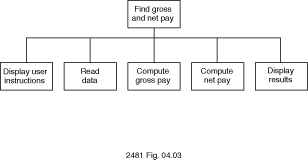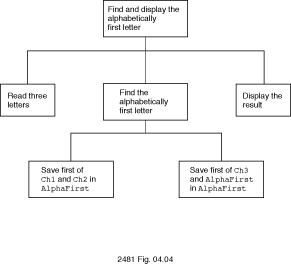
In the problem that follows, you will see how to improve the payroll program.
PROBLEM SPECIFICATION
Modify the simple payroll program to deduct a $25 tax only if an employee earns more than $100 and deduct no tax otherwise.
We will analyze this problem using the tools developed in the last chapter. Webegin by listing the data requirements and the algorithm.
Problem Constants
maximum salary without a tax deduction (TaxBracket = 100.00)
amount of tax deducted (Tax = 25.00)
Problem Inputs
hours worked (Hours : NonNegFloat)
hourly rate (Rate : NonNegFloat)
Problem Outputs
gross pay (Gross : NonNegFloat)
net pay (Net : NonNegFloat)
Relevant Formulas
gross pay = hourly rate * hours worked
net pay = gross pay - deductions
Unlike problem inputs, whose values may vary, problem constants have the
same values for each run of the program. Each constant value is associated with
an identifier (Tax and TaxBracket above). The program
style display following this problem describes the reason for this association.
The structure chart for this algorithm is given in Figure 4.3.
Figure 4.3 Structure Chart for Modified Payroll Program

1. Display user instructions.
2. Enter hours worked and hourly rate.
3. Compute gross salary.
4. Compute net salary.
5. Display gross salary and net salary.
Now let's write the refinement of algorithm step 4 as a decision step.
Step 4 Refinement
4.1. IF Gross > TaxBracket THEN
Deduct a tax of $25
ELSE
Deduct no tax
END IF;
The decision step is expressed in pseudocode, which is a mixture of everyday language and Ada used to describe algorithm steps.
To test this program, run it with several sets of data. One data set should yield a gross salary greater than $100.00, and the other should yield a gross salary less than $100.00. You should also test the program with a data set that yields a gross salary that is $0.00, one that yields a gross salary of exactly $100.00, and at least one for invalid inputs.
The modified payroll program is shown in Program 4.1.
Program 4.1
WITH Ada.Text_IO;
WITH Ada.Float_Text_IO;
PROCEDURE Modified_Payroll IS
------------------------------------------------------------------------
--| Computes and displays gross pay and net pay given an hourly
--| rate and number of hours worked. Deducts a tax of $25 if
--| gross salary exceeds $100; otherwise, deducts no tax.
--| Author: Michael B. Feldman, The George Washington University
--| Last Modified: July 1995
------------------------------------------------------------------------
SUBTYPE NonNegFloat IS Float RANGE 0.0 .. Float'Last;
TaxBracket : CONSTANT NonNegFloat := 100.00;
-- maximum salary for no deduction
Tax : CONSTANT NonNegFloat := 25.00; -- tax amount
Hours : NonNegFloat; -- inputs - hours worked, hourly rate
Rate: NonNegFloat;
Gross: NonNegFloat; -- outputs - gross pay, net pay
Net: NonNegFloat;
BEGIN -- Modified_Payroll
-- Enter Hours and Rate
Ada.Text_IO.Put (Item => "Hours worked > ");
Ada.Float_Text_IO.Get (Item => Hours);
Ada.Text_IO.Put (Item => "Hourly rate $");
Ada.Float_Text_IO.Get (Item => Rate);
Ada.Text_IO.New_Line;
-- Compute gross salary
Gross := Hours * Rate;
-- Compute net salary
IF Gross > TaxBracket THEN
Net := Gross - Tax; -- Deduct a tax amount
ELSE
Net := Gross; -- Deduct no tax
END IF;
-- Print Gross and Net
Ada.Text_IO.Put (Item => "Gross salary is $");
Ada.Float_Text_IO.Put (Item => Gross, Fore => 1, Aft => 2, Exp => 0);
Ada.Text_IO.New_Line;
Ada.Text_IO.Put (Item => "Net salary is $");
Ada.Float_Text_IO.Put (Item => Net, Fore => 1, Aft => 2, Exp => 0);
Ada.Text_IO.New_Line;
END Modified_Payroll;
Sample
RunHours worked > 37.5 Hourly rate $7.50 Gross salary is $281.25 Net salary is $256.25
The sample run shows one set of test data from the test plan.
PROGRAM STYLE
Use of Constants
Tax and TaxBracket appear in
the preceding IF statement and in Program 4.1. We might have been
tempted to insert the constant values (100.00 and 25.00) directly in the
IF statement, writing
IF Gross > 100.00 THEN
Net := Gross - 25.00;
ELSE
Net := Gross;
END IF;
There are two reasons why it is better style to use the
constants as we did originally. First, the original IF statement
is easier to understand because it uses the names Tax and
TaxBracket, which are descriptive, rather than numbers, which have
no intrinsic meaning. Second, a program written with constants is much easier
to modify than one that is not. If the tax bracket and tax value were to
change--and tax-related things always change--we would need to change only the
constant declaration. If the constant values were inserted directly in the
IF statement as just shown above, we would have to change them not
only in the IF statement but in all the other statements in which
they appeared. In a program of realistic length, finding all these occurrences
would be a tedious and error-prone process. For both reasons, we recommend that
you try to avoid dispersing constant values through your programs; instead use
constants that are declared by name.
Case Study: Finding the Alphabetically First Letter
Read three letters and find and display the one that comes first in the alphabet.
From our prior experience with conditions and decision steps, we know how tocompare two items at a time to see which one is smaller using the relational
operator <. We can also use this operator to determine whether one letter
precedes another in the alphabet. For example, the condition 'A' < 'F'
is true because A precedes F in the alphabet.
Because we have no direct way to compare three items, our strategy will be to
do a sequence of pairwise comparisons. We will start by comparing the first two
letters to find the smaller of that pair. The result of the second comparison
will be the smallest of the three letters.
Problem Inputs
three letters (Ch1, Ch2, Ch3 : Character).
Problem Outputs
the alphabetically first letter (AlphaFirst : Character).
1. Read three letters into Ch1, Ch2, and
Ch3.
2. Save the alphabetically first of Ch1, Ch2, and
Ch3 in AlphaFirst.
3. Display the alphabetically first letter.
Step 2 can be performed by first comparing Ch1 and
Ch2 and saving the alphabetically first letter in
AlphaFirst; this result can then be compared to Ch3.
The refinement of step 2 follows.
Step 2 Refinement
2.1. Save the alphabetically first of Ch1 and Ch2 in
AlphaFirst.
2.2. Save the alphabetically first of Ch3 and
AlphaFirst in AlphaFirst.
Figure 4.4 shows the structure chart that corresponds to this algorithm.
Figure
4.4
Structure Chart for Finding Alphabetically First Letter

Test this program with different sequences of letters, corresponding to the
possible orderings of three distinct letters. Also, test with cases where at
least two of the letters are equal. In this way, you are ensuring that each of
the paths through the IF statements are tested.
Program 4.2 shows the desired program. The
IF statement with two alternatives
saves either Ch1 or Ch2 in AlphaFirst.
The IF statement with one alternative stores Ch3 in
AlphaFirst if Ch3 precedes the value already in
AlphaFirst. Later you will see that IF statements
with more than two alternatives are also possible in Ada.
Program 4.2
WITH Ada.Text_IO;
PROCEDURE First_Letter IS
------------------------------------------------------------------------
--| Finds and prints the alphabetically first letter.
--| Author: Michael B. Feldman, The George Washington University
--| Last Modified: July 1995
------------------------------------------------------------------------
Ch1, Ch2, Ch3 : Character; -- input - three letters
AlphaFirst : Character; -- output - alphabetically first letter
BEGIN -- First_Letter
-- Read three letters
Ada.Text_IO.Put (Item => "Enter any three letters, then press ENTER > ");
Ada.Text_IO.Get (Item => Ch1);
Ada.Text_IO.Get (Item => Ch2);
Ada.Text_IO.Get (Item => Ch3);
-- Save the smaller of Ch1 and Ch2 in AlphaFirst
IF Ch1 < Ch2 THEN
AlphaFirst := Ch1; -- Ch1 comes before Ch2
ELSE
AlphaFirst := Ch2; -- Ch2 comes before Ch1
END IF;
-- Save the smaller of Ch3 and AlphaFirst in AlphaFirst
IF Ch3 < AlphaFirst THEN
AlphaFirst := Ch3; -- Ch3 comes before AlphaFirst
END IF;
-- Print result
Ada.Text_IO.Put (Item => AlphaFirst);
Ada.Text_IO.Put (Item => " is the first letter alphabetically");
Ada.Text_IO.New_Line;
END First_Letter;
Sample
RunEnter any three letters, then press ENTER > THE E is the first letter alphabeticallyTESTING
As usual, the sample output shows one of the test cases.
X := 25.0;
IF Y /= (X - 10.0) THEN
X := X - 10.0;
ELSE
X := X / 2.0;
END IF;
IF Y < 15.0 THEN
X := 5 * Y;
ELSE
X := 2 * Y;
END IF;
a. If Item is nonzero, multiply Product by
Item and save the result in Product; otherwise, skip
the multiplication. In either case, display the value of Product.
b. Store the absolute difference of X and Y in
Z, where the absolute difference is (X - Y) or
(Y - X), whichever is positive.
c. If X is zero, add 1 to ZeroCount. If
X is negative, add X to MinusSum. If
X is greater than zero, add X to
PlusSum.
Copyright © 1996 by Addison-Wesley Publishing Company, Inc.